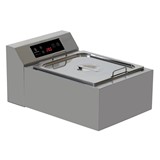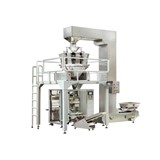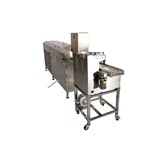Discover how to choose the best filling machine for your café, bar or catering business in Australia. Explore types, fit-out tips, hygiene compliance, financing, and ROI insights tailored for hospitality.
Key takeaways
- Filling machine prices: Entry-level semi-automatic liquid fillers start at $5,000–$8,000, while fully automatic rotary or volumetric machines range between $25,000–$150,000+, depending on speed, volume, and customisation.
- Machine types: Choose from liquid, powder, granule, paste, or aerosol fillers—each suited to different product consistencies and industries.
- Industries served: Filling machines are critical for food and beverage, pharmaceuticals, cosmetics, and chemicals, with strict hygiene and precision requirements.
- Operational capacity: Machines vary from 20 bottles per minute (BPM) for manual units to over 300 BPM for automated lines.
- Maintenance needs: Regular cleaning and lubrication can reduce downtime by up to 30% and extend equipment life.
- Compliance: Must meet Australian standards like AS4024 for machinery safety, and TGA or FSANZ requirements for medical and food applications.
- Financing options: Equipment financing or leasing can reduce upfront cost pressures, often with monthly repayments from $400–$2,000.
Introduction
Whether you're bottling sauces, creams, supplements, or chemicals, a filling machine is the backbone of efficient and scalable production. In Australia's highly regulated and quality-conscious market, choosing the right filling machine isn't just about speed—it's about compliance, hygiene, accuracy, and long-term return on investment.
This comprehensive guide is designed to help Australian businesses—from start-ups to manufacturers—navigate the options, prices, compliance requirements and financing choices to make informed, confident buying decisions.
Types of filling machines available in Australia
Selecting the right type depends on your product characteristics (liquid, powder, granule), container type, production speed, and accuracy requirements.
1. Liquid filling machines
- Gravity fillers: Ideal for thin, free-flowing liquids like water, spirits, and vinegar.
- Piston fillers: Better for thicker liquids (e.g., sauces, oils, lotions).
- Peristaltic fillers: Used for sterile applications in pharmaceuticals.
2. Powder and granule fillers
- Auger fillers: Suitable for flour, protein powders, spices.
- Volumetric cup fillers: Used for granules like coffee, seeds, or snacks.
3. Paste and viscous product fillers
- Servo-driven piston fillers: Ideal for creams, toothpaste, thick condiments.
- Vacuum fillers: Used in specialty applications like jam or honey.
4. Aerosol and gas fillers
- Used in packaging deodorants, spray paints, or chemical cleaners.
5. Inline vs rotary systems
- Inline fillers: Straight-line filling for smaller volumes (20–120 BPM).
- Rotary fillers: Circular systems for high-volume production (120–300+ BPM).
Pricing breakdown in Australia
- Manual and semi-automatic fillers typically range from $5,000 to $15,000. These are ideal for start-ups, test batches, or low-volume runs, offering a cost-effective entry point for small businesses or R&D use.
- Automatic inline fillers are priced between $25,000 and $60,000. These machines suit medium-scale operations in industries like food production or cosmetics, where increased throughput and filling consistency are required.
- Rotary high-speed systems start from around $80,000 and can exceed $150,000, depending on speed and customisation. They're commonly used in beverage, pharmaceutical, and contract packing facilities where high-volume output is critical.
- Powder auger fillers range from $18,000 to $50,000 and are commonly used in the supplements industry and for dry food ingredients, where dose precision and hygiene are essential.
- Custom fully integrated lines, which combine filling, capping, labelling, and conveyor systems, can cost between $120,000 and $300,000. These are best suited for large-scale, enterprise operations requiring automation and throughput at scale.
How filling machines operate
Most machines follow a basic cycle: container positioning → product dispensing → container exit.
Key operational components include:
- PLC control system for automation
- Sensors and actuators for precision
- Nozzles tailored for drip-free filling
- Conveyor system for container movement
Common output speeds:
- Semi-automatic: 15–30 BPM
- Inline automatic: 40–120 BPM
- Rotary fillers: 120–300+ BPM
Maintenance and spare parts
Routine maintenance improves longevity and uptime.
Maintenance tips:
- Daily: Clean nozzles and contact surfaces
- Weekly: Inspect hoses, pistons, valves
- Monthly: Lubricate moving parts, check alignment
Common parts needing replacement:
- Seals and gaskets
- Pistons
- O-rings
- Hoses and tubes
- Control panel components
Spare parts kits typically cost $500–$3,000, depending on machine size and make.
Financing your purchase
Australian businesses commonly use equipment financing to preserve working capital.
Options available:
- Equipment loan (secured asset-based lending)
- Finance lease
- Operating lease
Sample repayments:
- $30,000 machine over 5 years: approx. $650/month
- $100,000 machine over 5 years: approx. $2,000/month
Speak to a finance broker familiar with machinery in your industry for tailored rates and tax implications.
Warranties and after-sales support
Most Australian suppliers offer:
- 12–24 month warranty on components
- Optional extended warranty plans
- On-site training and commissioning
- Remote diagnostics and support
Ensure you ask about:
- Downtime guarantees
- Parts availability locally
- Turnaround time for repairs
Compliance and certification in Australia
Filling machines must adhere to:
- AS 4024: Australian safety standard for industrial machinery
- FSANZ Code: For food-safe equipment
- TGA regulations: For pharmaceutical fillers
- ISO certifications: ISO 9001 for quality management; ISO 22000 for food safety
Industry-specific use cases for hospitality
Whether you're running a café, a hotel, or a catering business, filling machines can dramatically improve your operational efficiency, product consistency and hygiene standards. In Australia's hospitality sector, these machines are no longer limited to manufacturers—they're increasingly used by venues looking to scale their in-house production and reduce outsourcing costs.
Here are just a few hospitality-specific use cases for filling machines:
- Hotels and resorts – Use filling machines to package in-house toiletries like shampoo, conditioner or body wash in reusable bottles, or to bottle water for in-room amenities.
- Cafés and restaurants – Fill cold brews, juices, sauces, salad dressings, or takeaway condiments with precision and consistency. Automating these tasks saves staff time and ensures portion control.
- Catering businesses – Portion gravies, soups, desserts, or custom sauces for events. A filling machine ensures faster prep and less mess—ideal for bulk meal production.
- Bars and breweries – Use filling equipment to bottle small-batch spirits, mixers, or craft beers for retail or takeaway, opening up new revenue streams under Australia’s evolving liquor packaging laws.
Space and utilities fit-out considerations
Hospitality venues often deal with limited floor space, shared kitchens, and the need for a seamless front- and back-of-house experience. Before investing in a filling machine, it’s critical to assess installation and utility requirements to avoid costly retrofitting or downtime.
Here’s what to keep in mind:
- Machine footprint – Manual and semi-auto fillers typically occupy 0.5–1.5 m², while automatic inline and rotary systems may require 2–6 m². Measure your prep area to ensure there’s room for both operation and cleaning.
- Power supply – Most machines for hospitality run on standard 240V single-phase power, but larger systems may require three-phase power. Confirm your venue’s electrical capacity before purchase.
- Compressed air – Pneumatic fillers need a compressed air supply (usually 4–6 bar). If you don’t have this already, you’ll need to factor in the cost of installing an air compressor.
- Noise levels – In open-plan cafés or customer-facing kitchens, opt for models with low decibel ratings to maintain a quiet, pleasant atmosphere.
- Mobility and cleaning – Machines fitted with lockable castors and stainless steel frames allow for quick repositioning and easy sanitation—vital in high-turnover food prep areas.
Frequently asked questions
What is the best filling machine for sauces?
A piston or servo-driven filler is ideal. These machines handle viscosity well and ensure accuracy in volume.
Can I fill both liquids and powders with one machine?
Not typically. Each product type requires a different mechanism. However, modular systems allow for switching heads.
What kind of training is needed?
Most suppliers offer 1–2 days of operator training. Larger systems may require ongoing support or third-party certifications.
How do I ensure my machine is food-safe?
Ensure materials are stainless steel (316 for contact parts), and that the machine complies with FSANZ guidelines and is easy to clean (CIP-capable).
What is the lead time for delivery?
Domestic stock may be delivered in 2–6 weeks. Custom or imported systems can take 10–20 weeks.
Final thoughts
Buying a filling machine in Australia is a significant investment—both financially and operationally. However, with the right due diligence, clear production goals, and an understanding of compliance and financing options, you can secure a machine that meets your needs today and scales with your business tomorrow.
For best results, compare multiple quotes, confirm service guarantees, and calculate your total cost of ownership—not just your upfront price.





-160x160-state_article-rel-cat.png)





-160x160-state_article-rel-cat.png)

-160x160-state_article-rel-cat.png)











